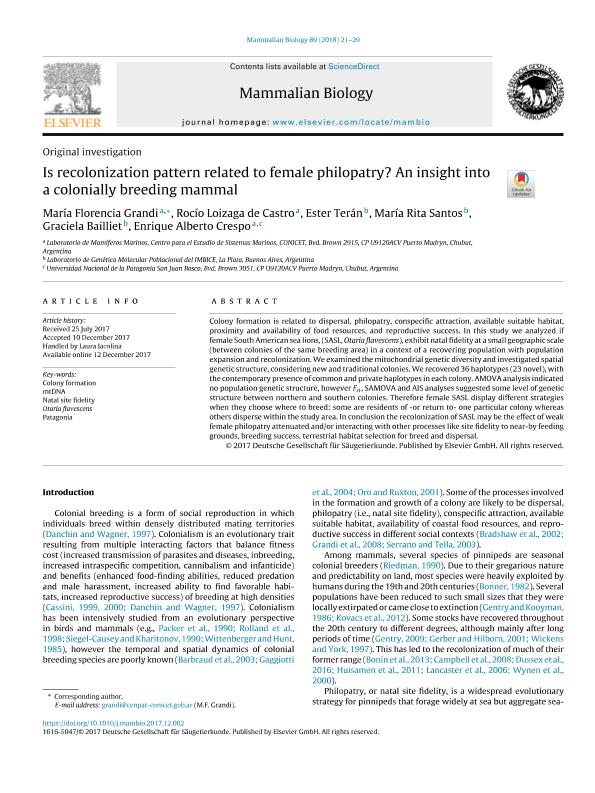Artículo
Is recolonization pattern related to female philopatry? An insight into a colonially breeding mammal
Grandi, Maria Florencia ; Loizaga de Castro, Rocio
; Loizaga de Castro, Rocio ; Teran, Ester Mercedes
; Teran, Ester Mercedes ; Santos, María Rita
; Santos, María Rita ; Bailliet, Graciela
; Bailliet, Graciela ; Crespo, Enrique Alberto
; Crespo, Enrique Alberto
 ; Loizaga de Castro, Rocio
; Loizaga de Castro, Rocio ; Teran, Ester Mercedes
; Teran, Ester Mercedes ; Santos, María Rita
; Santos, María Rita ; Bailliet, Graciela
; Bailliet, Graciela ; Crespo, Enrique Alberto
; Crespo, Enrique Alberto
Fecha de publicación:
03/2018
Editorial:
Elsevier Gmbh
Revista:
Mammalian Biology
ISSN:
1616-5047
Idioma:
Inglés
Tipo de recurso:
Artículo publicado
Clasificación temática:
Resumen
Colony formation is related to dispersal, philopatry, conspecific attraction, available suitable habitat, proximity and availability of food resources, and reproductive success. In this study we analyzed if female South American sea lions, (SASL, Otaria flavescens), exhibit natal fidelity at a small geographic scale (between colonies of the same breeding area) in a context of a recovering population with population expansion and recolonization. We examined the mitochondrial genetic diversity and investigated spatial genetic structure, considering new and traditional colonies. We recovered 36 haplotypes (23 novel), with the contemporary presence of common and private haplotypes in each colony. AMOVA analysis indicated no population genetic structure, however Fst, SAMOVA and AIS analyses suggested some level of genetic structure between northern and southern colonies. Therefore female SASL display different strategies when they choose where to breed: some are residents of -or return to- one particular colony whereas others disperse within the study area. In conclusion the recolonization of SASL may be the effect of weak female philopatry attenuated and/or interacting with other processes like site fidelity to near-by feeding grounds, breeding success, terrestrial habitat selection for breed and dispersal.
Palabras clave:
Colony Formation
,
Mtdna
,
Natal Site Fidelity
,
Otaria Flavescens
,
Patagonia
Archivos asociados
Licencia
Identificadores
Colecciones
Articulos(CESIMAR)
Articulos de CENTRO PARA EL ESTUDIO DE SISTEMAS MARINOS
Articulos de CENTRO PARA EL ESTUDIO DE SISTEMAS MARINOS
Articulos(IGEVET)
Articulos de INST.DE GENETICA VET ING FERNANDO NOEL DULOUT
Articulos de INST.DE GENETICA VET ING FERNANDO NOEL DULOUT
Articulos(IMBICE)
Articulos de INST.MULTIDISCIPL.DE BIOLOGIA CELULAR (I)
Articulos de INST.MULTIDISCIPL.DE BIOLOGIA CELULAR (I)
Citación
Grandi, Maria Florencia; Loizaga de Castro, Rocio; Teran, Ester Mercedes; Santos, María Rita; Bailliet, Graciela; et al.; Is recolonization pattern related to female philopatry? An insight into a colonially breeding mammal; Elsevier Gmbh; Mammalian Biology; 89; 3-2018; 21-29
Compartir
Altmétricas



